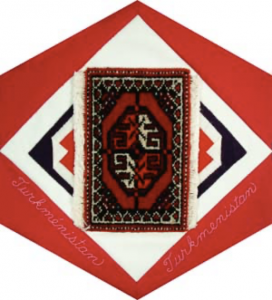Turkmenistan

The Block
The craft of carpet-weaving has a long history in Turkmenistan that continues to this day––factories throughout the country turn out over 40,000 square metres of carpets a year. Appropriately then, the Turkmenistan block honours this centuries-old tradition with an authentic rug-sample provided by Carol Ritchie and Slavik Kazakov. Turkmen carpets, commonly called Bukhara, after the ancient city in which traders sold their wares, are part of the country’s rich historical legacy and are known the world over. The world’s largest hand-woven wool carpet, which is housed in Turkmenistan’s Carpet Museum, is featured in the Guinness Book of Records. Bukhara are traditionally hand-crafted in rich hues of red, burgundy, plum, green, brown, cream and black; the same colours that dominate Turkmen clothing. They feature geometric tribal designs that have been used for centuries by the Turkmen people and are created from only 100% pure wool of the Saryja sheep, indigenous to Turkmenistan. The highly nutritional vegetation of Turkmenistan’s pastures provides the sheep’s wool with valuable properties, including the ability to easily absorb moisture and release it back, a high concentration of fibres, and flexibility. The carpets, as a result, have not only an amazing beauty, but great longevity as well. They are perfect for the nomadic lifestyle much of the country’s inhabitants still live, and serve several purposes within the home. In addition to being used as wall-hangings, they also function as seat-coverings and as insulation against cold desert nights.
Cultural Profile
Turkmenistan, which was until 1991 part of the Soviet Union, is the second largest nation in Central Asia. The Kopet Dag, meaning ‘Lots of Mountain’, mountain range lies along the southern boundaries of the country, which borders the Caspian Sea between Iran and Kazakhstan. Nearly three-quarters of the nation is occupied by the rolling dunes and plateaus of the Garagum Desert––one of the world’s largest sand deserts––and one-half of its irrigated land is planted in cotton. Turkmenistan is the world’s 10th-largest producer of the crop. Turkmenistan also possesses the planet’s fourth-largest reserves of natural gas. Turkmen constitute more than 70 percent of the population, making the country the most ethnically homogeneous of the Central Asian republics. Uzbeks are the largest minority group followed by smaller clusters of Russians, Kazakhs, Ukrainians and Armenians. The official language is Turkmen, although Russian is widely spoken throughout the land.
A Turkmenistan saying states that “Water is a Turkmen’s life, a horse is his wings, and a carpet is his soul.” The Turkmen people have traditionally been horse-breeding nomads, well-known for their horsemanship and the famed Akhal-Teke horse––the breed once ridden by Alexander the Great––and, although nearly half of the inhabitants now live in urban areas, many people still a practice a rural existence. It is common for members of a large extended family to live under the same roof, with special respect given to elders as they are seen as a source of wisdom and advice.
Folk arts remain an important part of the culture and such crafts as embroidery and carpet-weaving generally feature distinct patterns that identify specific tribes. Men’s clothing typically consists of baggy pants, a red robe over a white shirt and a telpek, the large, black sheepskin hat that resembles an afro. Women wear long, velvet dresses over embroidered-at-the hem pants and the occasional ornate headdress decorated with silver jewellery and precious stones. A woman’s clothing not only denotes her tribe, but combined with her hairstyle, indicates her marital status: two braids and and a small headscarf means ‘unmarried’ while a single braid and a large scarf means ‘married.’
Turkmens have an oral literary tradition that dates from ancient times and their epics are still sung by revered poets and composers called bakhski. An important tradition within their music, which is closely related to Kyrgyz and Kazakh folk styles, the bakhskis are travelling singers and shamans who act as healers and magicians. They play the dutar, a stringed instrument resembling the Iranian saz.
People have been coming to Canada from Turkmenistan since 1992; prior to that they were listed under ‘Russia’ in immigration records.
Sponsor: Pat and John Brittain
